Eight from St. Peter’s enjoyed an exhibit of 60 Renaissance- and Baroque-era paintings from many museums around the globe all depicting Mary. The exhibit is at the National Museum of Women in the Arts in Washington. The trip was an extension of our Advent study on Mary, “Singing Mary’s Song” and led by artist Susan Tilt. It will continue until April 12.
Art
Stained glass repair 2011-2012
Back in November, 2011, we had a post about work to restore stained glass windows on both the left and right side of the church. One was cracked on the right side and there was a missing rose medallion on the left. Through a generous donation, the work is complete and installed on Feb. 23, 2012. Stained Glass by Shenandoah had to order special paint from France to complete the work. The results can be seen here in photos taken by the company.
The Art of the “Feeding of the 5,000”
The Visual Commentary on Scripture featires 3 paintings that depict the scripture in three periods -early 1500 1671, and 1796. From VCS (Visual Commentary on Scripture). The link to the paintings and then the discussion.
The Feeding of the Five Thousand can be found in all four canonical Gospels (Matthew 14:13–21; Mark 6:32–44; Luke 9:10–17; John 6:1–15), and the Feeding of the Four Thousand in two (Mark 8:1–10; Matthew 15:29–39). The miracle emphasizes Christ’s caring concern and compassion, but also his hospitality and his generosity as a host.
In all three paintings in this exhibition, the central motif is Christ’s gesture of blessing and the baskets in which food will be distributed and leftovers collected. Bartolomé Esteban Murillo follows John’s version of the miracle, while Lambert Lombard’s interpretation is a more complex blending of narratives, and Francisco de Goya’s sources are less clear. Their approaches to the representation of the crowds are also different. Traditionally, Jesus’s followers are depicted either as a gathering of individuals whose diversity provides the painter with an opportunity to display his originality and skills, or as an undefined multitude.
Artists like Lombard suggest the breadth and universality of God’s message by showing its recipients as individuals of varying ages, genders, status, and ethnicities. In Murillo’s and Goya’s works, lack of definition turns these individuals into a mass, which evinces the magnitude of Christ’s following and the extent of his miraculous powers. Both Lombard and Murillo divide the crowd into small groups: Luke refers to ‘groups of about fifty each’ (9:14–15), while in the Gospel of Mark ‘they sat down in groups, by hundreds and by fifties’ (6:40). The wide sweep of Murillo’s landscape is populated by a large, expectant congregation, which in Goya’s interpretation becomes a barely sketched crowd agitated by a threatening, simmering sense of unrest.
Lambert Lombard – “The Miracle of the Loaves and Fishes”. First half of 16th century.

Bartolome Estaban Murillo – The Multiplication of the Loaves and Fishes”. 1671

Francisco de Goya – The Multiplication of the Loaves and Fishes. 1795–96

Daniel Bonnell on his painting, “Feeding of the 5,000”
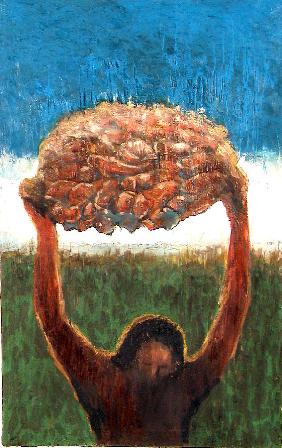
"This is an important divine moment here that perhaps we miss. The scripture says that Jesus took the loaves, gave thanks, and distributed the loaves and the fishes. All eyes are on Him as the crowd is instructed to sit down in the grass. He then gave thanks. In this painting all the focus is upon Jesus, the viewer looks up as if he or she were one of the crowd. Jesus raises a basket with two small fish in it to the sky. He gives thanks and before he finishes speaking the basket is filled to overflowing. Jesus is called the bread of life. We see Him performing many miracles that have symbolic meanings to those — that have eyes to see. He is victory over death. We see Him raising the dead in more than one instance. He is the water of life, as he tells the woman at the well. He is the Prophet who knew of her five husbands. Look closer and you will see Jesus not just raising a basket of bread to the sky but you will see him upon the cross. The band of white sky forms a perpendicular bar with his arms and hands, which are pierced."
Summer Diversions
"so much depends
upon
a red wheel
barrow
glazed with rain
water
beside the white
chickens."
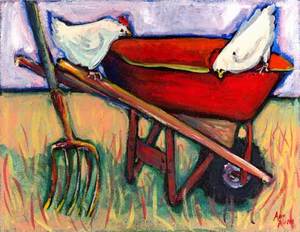
The poem is "The Red Wheelbarrow" William Carlos Williams, 1883 – 1963
Williams called this poem "quite perfect" and since its publication in 1923 it has been a staple of classrooms. People have wondered " Where is this wheelbarrow and who owned it ?" But now 90 years later the owner of the wheelbarrow has been identified.
On July 18, in a moment of belated poetic justice, a stone will be laid on the otherwise unmarked grave of Thaddeus Marshall, an African-American street vendor from Rutherford, N.J., noting his unsung contribution to American literature.
William Logan a professor at the University of Florida has published an essay on the poem in the most recent issue of the literary journal Parnassus It considers the poem from seemingly every conceivable angle. But also traces back the owner of the wheelbarrow. The story is the subject of a NY Times book review article
In a note quoted in a 1933 anthology, Williams said he had seen the wheelbarrow “outside the window of an old negro’s house on a backstreet” in Rutherford, where Williams also lived and regularly paid house calls to patients in the African-American neighborhood.
Logan’s clues for identifying Marshall came from the 1920 census, a 1917 insurance map and the help of a local historian. The man – Thaddeus Marshall, a 69-year-old widower who lived with a son named Milton at 11 Elm Street, about nine blocks from Williams’s house. He located a great-granddaughter, Teresa Marshall Hale, of Roselle, N.J., who grew up in the house on Elm Street and recalled family stories about her great-grandfather selling eggs and vegetables.
Funds were raised for a marker on Marhsall’s grave since he was buried without a headstone. A red and white wreath, signifying the red wheelbarrow and white chickens, will be laid beside it.
Just as religion, poetry is important to us as a way to go deeper within ourselves, a different way of viewing experience. Images like this become part of whom we are.
A Unique Monastery in Africa
Keur Moussa means ‘House of Moses’. The House of Moses Monastery was founded in Senegal in Western Africa in 1961 by French monks from the order of St Benedict. The monastery is known for its art, music and its service with both African and European forms. You can see this in the following video.
Today, Keur Moussa has 30 to 40 brothers. The abbey also sponsors an elementary school and dispensary, run by sisters and laypeople. The monks themselves live from the work of their hands, tending fruit trees, making cheese, and hand-crafting their musical instrument known as koras.
The altar has images on both the wall and ceiling.

It also has one of the unique Death of John the Baptist depictions.
Robert Harding, photographer, took a series of photos there. This one is “Head of Baptist, mural by Father George Saget (1963) fits in with the Gospel on July 14.
This image shows not just the execution but a diverse crowd reaction. People on the far right are very sad and withdrawn, a natural reaction. Those two to the left have their hands up. This can mean several things – they don’t want to be associated with it, they are appalled by it, they are reviled by it. They have at least confronted it.
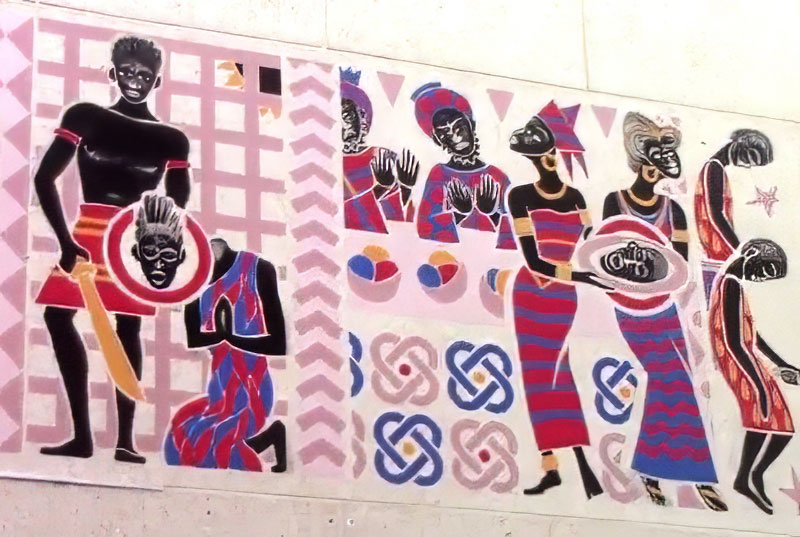
Visual Lectionary Vanderbilt, 7th Sunday after Pentecost, July 7, 2024
Click here to view in a new window.
Jan’s book for Catherine’s Farewell
Jan Saylor constructed a book for Catherine’s farewell with memories from friends. This is the cover, the first three pages and the invitation for June 30. What an amazing work!
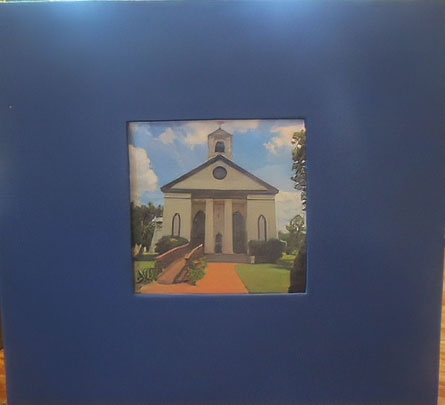

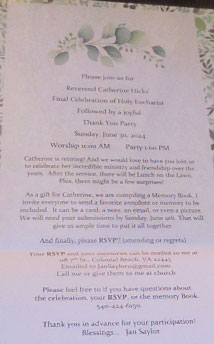
Voices of Pentecost 5 – Mark’s Gospel

The Storm on the Sea of Galilee– Rembrandt (1633)
This is Rembrandt’s only seascape picture and dramatically depicts Mark’s Gospel. Being lost at sea was a constant threat at the time. Rembrandt did not try to capture historical accuracy but used boats of his time. Ironically, this painting is now lost. On the morning of March 18, 1990, thieves disguised as police officers broke into the Isabella Stewart Gardner museum in Boston and stole The Storm on the Sea of Galilee and 12 other works. It is considered the biggest art theft in US history and remains unsolved. The museum still displays the paintings’ empty frames in their original locations.
The museum describes the painting- “The detailed rendering of the scene, the figures’ varied expressions, the relatively polished brushwork, and the bright coloring are characteristic of Rembrandt’s early style…The panic-stricken disciples struggle against a sudden storm, and fight to regain control of their fishing boat as a huge wave crashes over its bow, ripping the sail and drawing the craft perilously close to the rocks in the left foreground. One of the disciples succumbs to the sea’s violence by vomiting over the side. Amidst this chaos, only Christ, at the right, remains calm, like the eye of the storm. Awakened by the disciples’ desperate pleas for help, he rebukes them: “Why are ye fearful, O ye of little faith?” and then rises to calm the fury of wind and waves.”
“Set me alight We’ll punch a hole right through the night Everyday the dreamers die See what’s on the other side “
-U2 “In God’s Country”
“People fear miracles because they fear being changed.” Which is the source, I think, of this other kind of fear that stands somewhere between a holy awe and mighty terror: the fear of being changed. And make no mistake, Jesus is asking the disciples to change. In this very moment he is drawing them from the familiar territory of Capernaum to the strange and foreign land of the Garasenes. And he is moving them from being fishermen to disciples. And he is preparing them to welcome a kingdom so very different from the one they’d either expected or wanted.”
“The change they are facing is real, and hard, and inevitable, and all of this becomes crystal clear as they realize the one who is asking them to change has mastery over the wind and see and is, indeed, the Holy One of God. That change, of course, will also and ultimately be transformative, but I doubt if they see that yet.”
– David Lose, President of Luther Seminary
Exploring Rublev’s famous Trinity Icon
This was written by Bill Gaultiere published by Trinity Episcopal

“Andrei Rublev painted “The Hospitality of Abraham in 1411” for the abbot of the Trinity Monastery in Russia. Rublev portrayed what has become the quintessential icon of the Holy Trinity by depicting the three mysterious strangers who visited Abraham (Genesis 18:1-15).
“In the Genesis account the Lord visits Abraham in the form of three men who are apparently angels representing God. Abraham bows low to the ground before his three visitors and they speak to Abraham in union and are alternatively referred to by the Genesis writer as “they” or “the Lord.” Abraham offers them the hospitality of foot washing, rest under a shade tree, and a meal and they offered him the announcement that God was going to give he and his wife Sarah a son, though Sarah was far past the age of childbearing.
“Rublev was the first to paint only the three angelic figures and to make them of equal size. Rublev depicts the three as One Lord. Each holds a rod in his left hand, symbolizing their equality. Each wears a cloak of blue, the color of divinity. And the face of each is exactly the same, depicting their oneness.
“The Father is like the figure on the left. His divinely blue tunic is cloaked in a color that is light and almost transparent because he is the hidden Creator. With his right he blesses the Son – he is pleased with the sacrifice he will make. His head is the only one that is lifted high and yet his gaze is turned to the other two figures.
“The Son is portrayed in the middle figure. He wears both the blue of divinity and reddish purple of royal priesthood. He is the King who descends to serve as priest to the people he created and to become part of them. With his hand he blesses the cup he is to drink, accepting his readiness to sacrifice himself for humanity. His head is bowed in submission to the Father on the left.
“The Spirit is indicated in the figure on the right. Over his divinely blue tunic he wears a cloak of green, symbolizing life and regeneration. His hand is resting on the table next to the cup, suggesting that he will be with the Son as he carries out his mission. His head is inclined toward the Father and the Son. His gaze is toward the open space at the table.
“Did you notice the beautiful circular movement in the icon of Father, Son, and Spirit? The Son and the Spirit incline their heads toward the Father and he directs his gaze back at them. The Father blesses the Son, the Son accepts the cup of sacrifice, the Spirit comforts the Son in his mission, and the Father shows he is pleased with the Son. Love is initiated by the Father, embodied by the Son, and accomplished through the Spirit.”
From Henro Nouwen, Dutch priest (psychology professor, writer, theologian) writing more than 500 years after this painting, “The more we look at this holy image with the eyes of faith, the more we come to realize that it is painted not as a lovely decoration for a convent church, nor as a helpful explanation of a difficult doctrine, but as a holy place to enter and stay within.”
Ascension Art
The Ascension has always been a challenge to understand through the scriptures. Artists have played a role in giving us a visual depiction of the event. They have been doing this for over a 1000 years.
By the 6th century the iconography of the Ascension had been established and by the 9th century Ascension scenes were being depicted on domes of churches.
There are many traditions in Ascension art.
In some representations there may be no mountain and he may be climbing a mandorla, or be lifted towards Heaven in a mandorla by angels.
In the Eastern Church and in some western paintings, the Virgin Mary is at the center of the group of Apostles (representing the Church) who look upwards towards the ascending Christ.
In Romanesque depictions sometimes just the feet of Christ are shown as he disappears up into the clouds; this depiction became the most popular in Northern Europe, where it lingered in provincial wood reliefs until well after the Reformation.
Ascension scenes fall naturally into two zones, an upper heavenly part and a lower earthly part. The ascending Christ may be carrying a resurrection banner or make a sign of benediction with his right hand. The blessing gesture by Christ with his right hand is directed towards the earthly group below him and signifies that he is blessing the entire Church. In the left hand he may be holding a Gospel or a scroll, signifying teaching and preaching. From the Renaissance on the angels may not be present.
The earthly part of the Ascension depictions do not only represent those believed to have been present at the Ascension, but the entire Church. In some Ascension depictions both Apostle Paul and the Virgin Mary may be present. Given Paul converted to Christianity after the Ascension, and that the New Testament does not directly place the Virgin Mary at the Ascension, these depictions represent "the Church" rather than the specific individuals
More modern views often omit the disciples focusing on Jesus. The sky in many cases is not specifically shown and he is alone. One of the most radical is Dali’s horizontal Jesus. Another type of image is a three dimensional space emphasizing Christ’s movement, accompanied by brilliant colors.
Artists for Climate
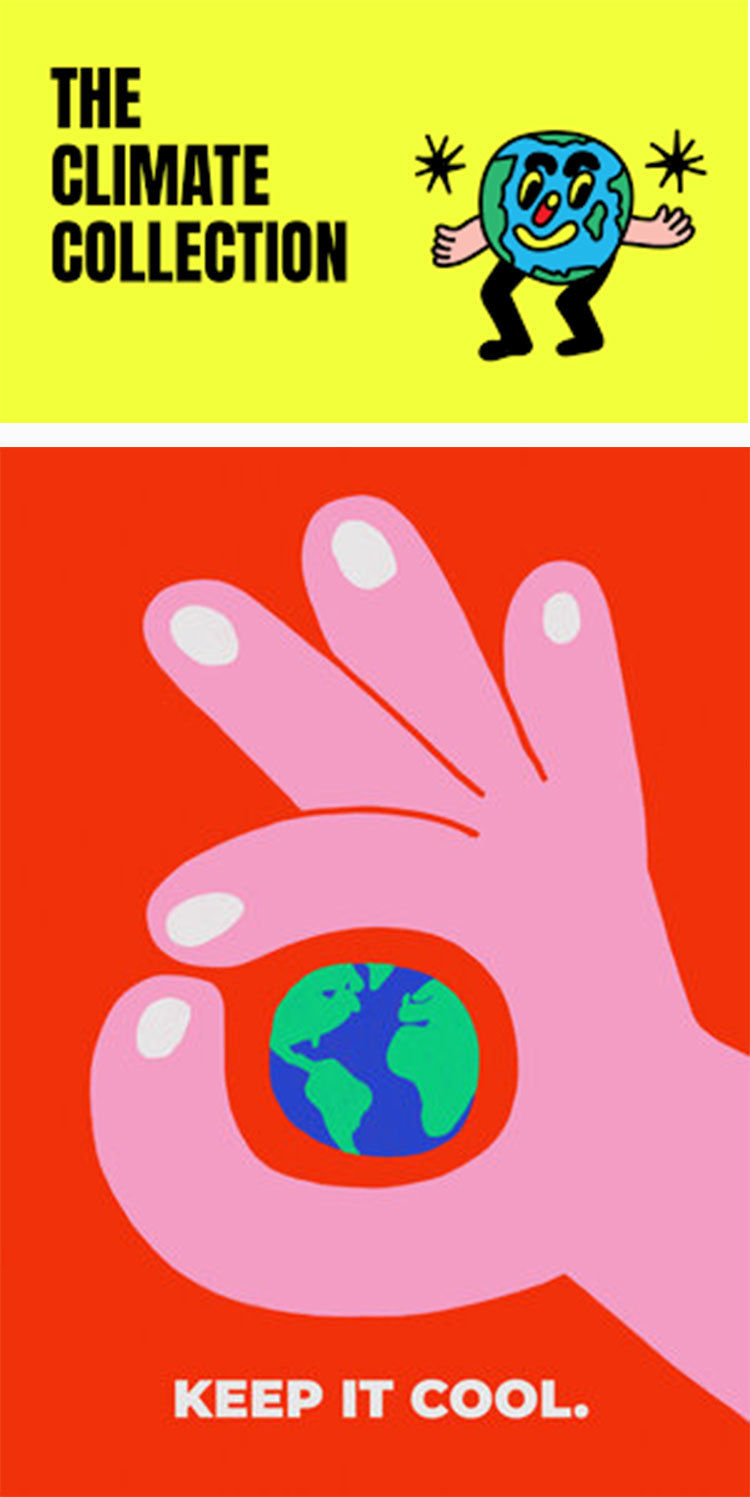
Just in time for Rogation Sunday!
In 2021, TED Countdown launched a partnership with Fine Acts – a global creative studio for social impact – to kick off a series of SPRINTS, creative boot camps held at TEDx events worldwide.
The goal: Engage artists to envision a better future. In three years, this extraordinary collaboration has produced hundreds of inspiring works for The Climate Collection – a unique vault of open-license visuals.
They are here
Visual Lectionary Vanderbilt, Second Sunday of Easter, April 7, 2024
Click here to view in a new window.
Good Friday art – Andrea Di Bonaiuto
Andrea Di Bonaiuto
Road to Calvary, Crucifixion, and Descent into Limbo, c.1365, Fresco,
Spanish Chapel, Santa Maria Novella, Florence

Commentary by Paula Nuttall for theVCS.org
“Located opposite the entrance, the fresco dramatically confronts the visitor. Dominating the scene at top centre, Christ hangs on the cross above a multitude of figures, the two thieves to either side, all three figures prominent by virtue of their pale forms silhouetted against the dark sky.
The Stations go up…
The Stations of the Cross were put up on Wed., Feb. 28. Thanks to Catherine and Larry for their labors:


These are Mary Peterman’s drawings from 2019 that we put on posters for Easter, 2023.
The Stations of the Cross began as the practice of pious pilgrims to Jerusalem who would retrace the final journey of Jesus Christ to Calvary.
Later, for the many who wanted to pass along the same route, but could not make the trip to Jerusalem, a practice developed that eventually took the form of the fourteen stations currently found in almost every church. This allowed people to follow the way in their hearts as they meditated on the last hours of Jesus’ life.
The stations can be walked in a small group or in solitude. Meditating on the words for each station, and on Mary’s watercolors, will be a spiritual experience that will deepen your relationship to Jesus and your faith.
Walking the stations of the cross also remind us that Jesus lived and died as one of us, and knew horrible suffering. As we travel with him through his last hours, we come to know that Jesus travels with us in our hours of greatest need.
Here is a gallery from last year of the complete set :
Visual Lectionary Vanderbilt, First Sunday in Lent, Feb. 18, 2024
Click here to view in a new window.
Rafael’s Transfiguration – the Story of a Painting

Raphael (1483-1520) was a master painter of the Renaissance. Raphael considered the Transfiguration to be his greatest masterpiece though he died before he could finish it at age 37. A student finished it.
In his final delirium he asked to see his painting for the last time. His friends brought it to him, and placed it on the bed in which he died on Good Friday, 1520.
Giorgio Vasari, the sixteenth century Italian painter, writer, historian said of the painting that is was “…the most famous, the most beautiful and most divine…”

